MGT502 Report: Exploring Digital Media in Business Communication
VerifiedAdded on 2023/06/12
|10
|2780
|211
Report
AI Summary
This report examines the increasing importance of digital media platforms in business communication, highlighting their impact on internal and external stakeholder engagement. It discusses the advantages of digitalization, such as improved employee communication, enhanced customer relationship management through tools like Salesforce and Slack, and efficient feedback mechanisms. The report also addresses the disadvantages, including over-reliance on technology, security concerns, and potential data breaches. Recommendations are provided to mitigate these challenges, including careful tool selection, comprehensive employee training, robust security measures, data backups, and proactive social listening. The report concludes that while the future of digitalization in business is promising, organizations must address the challenges to fully leverage its benefits. Desklib provides access to this and other solved assignments.

Business Communication
Advancement of digital media in business
Advancement of digital media in business
Paraphrase This Document
Need a fresh take? Get an instant paraphrase of this document with our AI Paraphraser

JYOTI
00160199T
Introduction
Digital media platforms are gaining traction throughout the globe. The advancement of digital
media in the workplace is occurring at a mammoth pace. This advancement has helped
organizations in enabling effective communications among internal and external stakeholders of
the business (Markovitch & Willmott, 2014). Digital marketing in business serves various
purposes including improving employee communication, enhancing customer management
efficacy and enabling a competent feedback mechanism (Cameron & Bazelon, 2011). There are
sundry tools available in the market that are being used by organizations. This report highlights
upon the importance of digital media in business, its challenges and recommendations to
overcome the same.
Digital tools
Source 1: Pinterest
Slack is a unique tool which is used by various organizations. The tool is being used with the
intention of ensuring transparent communication in the workplace. It is a cloud based tool which
keeps information secure. It was founded by Stewart Butterfield in 2013. The term SLACK is an
acronym for ‘Searchable Log for All Conversation and Knowledge’. The tool has various
features like chat rooms, searchable files and conversations as well as the ability to integrate
services such as Google drive, Trello, DropBox, and Zapier.
Salesforce is a leading software which is being used by organization in order to maintain the data
of their existing and potential customers. The tool can be customized for different organizations
based upon the nature of the business. Salesforce allows organizations to keep a track about
various details about their existing customers including their conversations with the company
00160199T
Introduction
Digital media platforms are gaining traction throughout the globe. The advancement of digital
media in the workplace is occurring at a mammoth pace. This advancement has helped
organizations in enabling effective communications among internal and external stakeholders of
the business (Markovitch & Willmott, 2014). Digital marketing in business serves various
purposes including improving employee communication, enhancing customer management
efficacy and enabling a competent feedback mechanism (Cameron & Bazelon, 2011). There are
sundry tools available in the market that are being used by organizations. This report highlights
upon the importance of digital media in business, its challenges and recommendations to
overcome the same.
Digital tools
Source 1: Pinterest
Slack is a unique tool which is used by various organizations. The tool is being used with the
intention of ensuring transparent communication in the workplace. It is a cloud based tool which
keeps information secure. It was founded by Stewart Butterfield in 2013. The term SLACK is an
acronym for ‘Searchable Log for All Conversation and Knowledge’. The tool has various
features like chat rooms, searchable files and conversations as well as the ability to integrate
services such as Google drive, Trello, DropBox, and Zapier.
Salesforce is a leading software which is being used by organization in order to maintain the data
of their existing and potential customers. The tool can be customized for different organizations
based upon the nature of the business. Salesforce allows organizations to keep a track about
various details about their existing customers including their conversations with the company
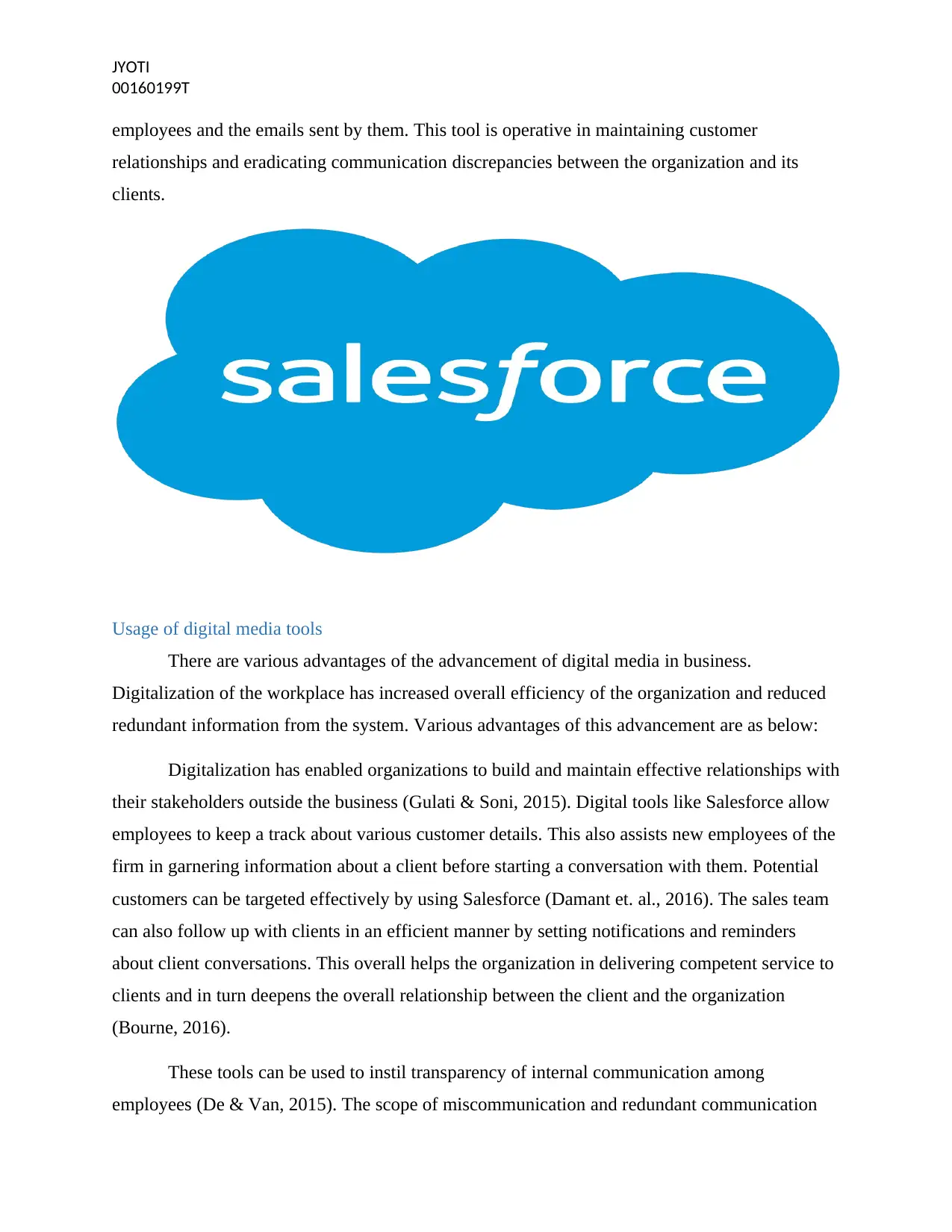
JYOTI
00160199T
employees and the emails sent by them. This tool is operative in maintaining customer
relationships and eradicating communication discrepancies between the organization and its
clients.
Usage of digital media tools
There are various advantages of the advancement of digital media in business.
Digitalization of the workplace has increased overall efficiency of the organization and reduced
redundant information from the system. Various advantages of this advancement are as below:
Digitalization has enabled organizations to build and maintain effective relationships with
their stakeholders outside the business (Gulati & Soni, 2015). Digital tools like Salesforce allow
employees to keep a track about various customer details. This also assists new employees of the
firm in garnering information about a client before starting a conversation with them. Potential
customers can be targeted effectively by using Salesforce (Damant et. al., 2016). The sales team
can also follow up with clients in an efficient manner by setting notifications and reminders
about client conversations. This overall helps the organization in delivering competent service to
clients and in turn deepens the overall relationship between the client and the organization
(Bourne, 2016).
These tools can be used to instil transparency of internal communication among
employees (De & Van, 2015). The scope of miscommunication and redundant communication
00160199T
employees and the emails sent by them. This tool is operative in maintaining customer
relationships and eradicating communication discrepancies between the organization and its
clients.
Usage of digital media tools
There are various advantages of the advancement of digital media in business.
Digitalization of the workplace has increased overall efficiency of the organization and reduced
redundant information from the system. Various advantages of this advancement are as below:
Digitalization has enabled organizations to build and maintain effective relationships with
their stakeholders outside the business (Gulati & Soni, 2015). Digital tools like Salesforce allow
employees to keep a track about various customer details. This also assists new employees of the
firm in garnering information about a client before starting a conversation with them. Potential
customers can be targeted effectively by using Salesforce (Damant et. al., 2016). The sales team
can also follow up with clients in an efficient manner by setting notifications and reminders
about client conversations. This overall helps the organization in delivering competent service to
clients and in turn deepens the overall relationship between the client and the organization
(Bourne, 2016).
These tools can be used to instil transparency of internal communication among
employees (De & Van, 2015). The scope of miscommunication and redundant communication
⊘ This is a preview!⊘
Do you want full access?
Subscribe today to unlock all pages.

Trusted by 1+ million students worldwide
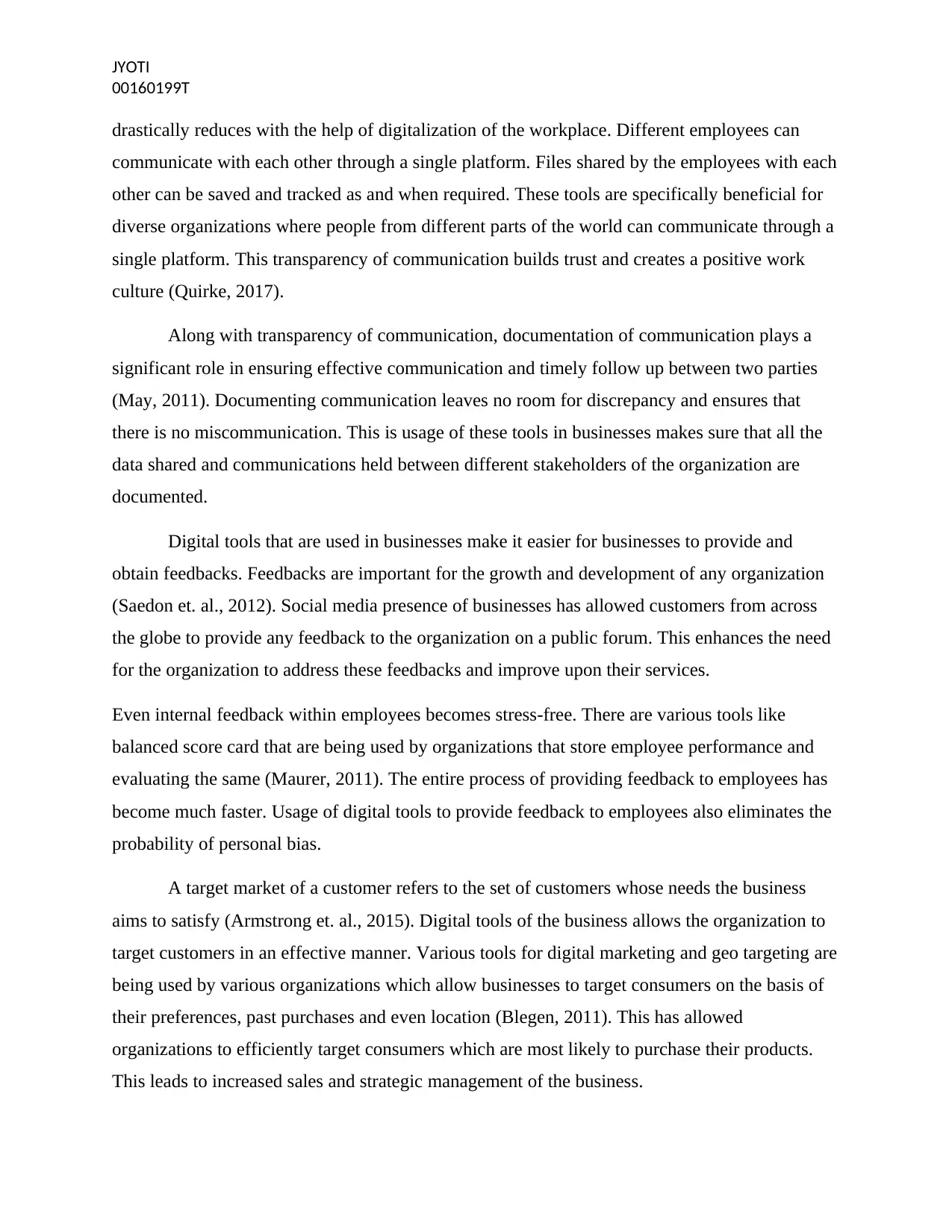
JYOTI
00160199T
drastically reduces with the help of digitalization of the workplace. Different employees can
communicate with each other through a single platform. Files shared by the employees with each
other can be saved and tracked as and when required. These tools are specifically beneficial for
diverse organizations where people from different parts of the world can communicate through a
single platform. This transparency of communication builds trust and creates a positive work
culture (Quirke, 2017).
Along with transparency of communication, documentation of communication plays a
significant role in ensuring effective communication and timely follow up between two parties
(May, 2011). Documenting communication leaves no room for discrepancy and ensures that
there is no miscommunication. This is usage of these tools in businesses makes sure that all the
data shared and communications held between different stakeholders of the organization are
documented.
Digital tools that are used in businesses make it easier for businesses to provide and
obtain feedbacks. Feedbacks are important for the growth and development of any organization
(Saedon et. al., 2012). Social media presence of businesses has allowed customers from across
the globe to provide any feedback to the organization on a public forum. This enhances the need
for the organization to address these feedbacks and improve upon their services.
Even internal feedback within employees becomes stress-free. There are various tools like
balanced score card that are being used by organizations that store employee performance and
evaluating the same (Maurer, 2011). The entire process of providing feedback to employees has
become much faster. Usage of digital tools to provide feedback to employees also eliminates the
probability of personal bias.
A target market of a customer refers to the set of customers whose needs the business
aims to satisfy (Armstrong et. al., 2015). Digital tools of the business allows the organization to
target customers in an effective manner. Various tools for digital marketing and geo targeting are
being used by various organizations which allow businesses to target consumers on the basis of
their preferences, past purchases and even location (Blegen, 2011). This has allowed
organizations to efficiently target consumers which are most likely to purchase their products.
This leads to increased sales and strategic management of the business.
00160199T
drastically reduces with the help of digitalization of the workplace. Different employees can
communicate with each other through a single platform. Files shared by the employees with each
other can be saved and tracked as and when required. These tools are specifically beneficial for
diverse organizations where people from different parts of the world can communicate through a
single platform. This transparency of communication builds trust and creates a positive work
culture (Quirke, 2017).
Along with transparency of communication, documentation of communication plays a
significant role in ensuring effective communication and timely follow up between two parties
(May, 2011). Documenting communication leaves no room for discrepancy and ensures that
there is no miscommunication. This is usage of these tools in businesses makes sure that all the
data shared and communications held between different stakeholders of the organization are
documented.
Digital tools that are used in businesses make it easier for businesses to provide and
obtain feedbacks. Feedbacks are important for the growth and development of any organization
(Saedon et. al., 2012). Social media presence of businesses has allowed customers from across
the globe to provide any feedback to the organization on a public forum. This enhances the need
for the organization to address these feedbacks and improve upon their services.
Even internal feedback within employees becomes stress-free. There are various tools like
balanced score card that are being used by organizations that store employee performance and
evaluating the same (Maurer, 2011). The entire process of providing feedback to employees has
become much faster. Usage of digital tools to provide feedback to employees also eliminates the
probability of personal bias.
A target market of a customer refers to the set of customers whose needs the business
aims to satisfy (Armstrong et. al., 2015). Digital tools of the business allows the organization to
target customers in an effective manner. Various tools for digital marketing and geo targeting are
being used by various organizations which allow businesses to target consumers on the basis of
their preferences, past purchases and even location (Blegen, 2011). This has allowed
organizations to efficiently target consumers which are most likely to purchase their products.
This leads to increased sales and strategic management of the business.
Paraphrase This Document
Need a fresh take? Get an instant paraphrase of this document with our AI Paraphraser
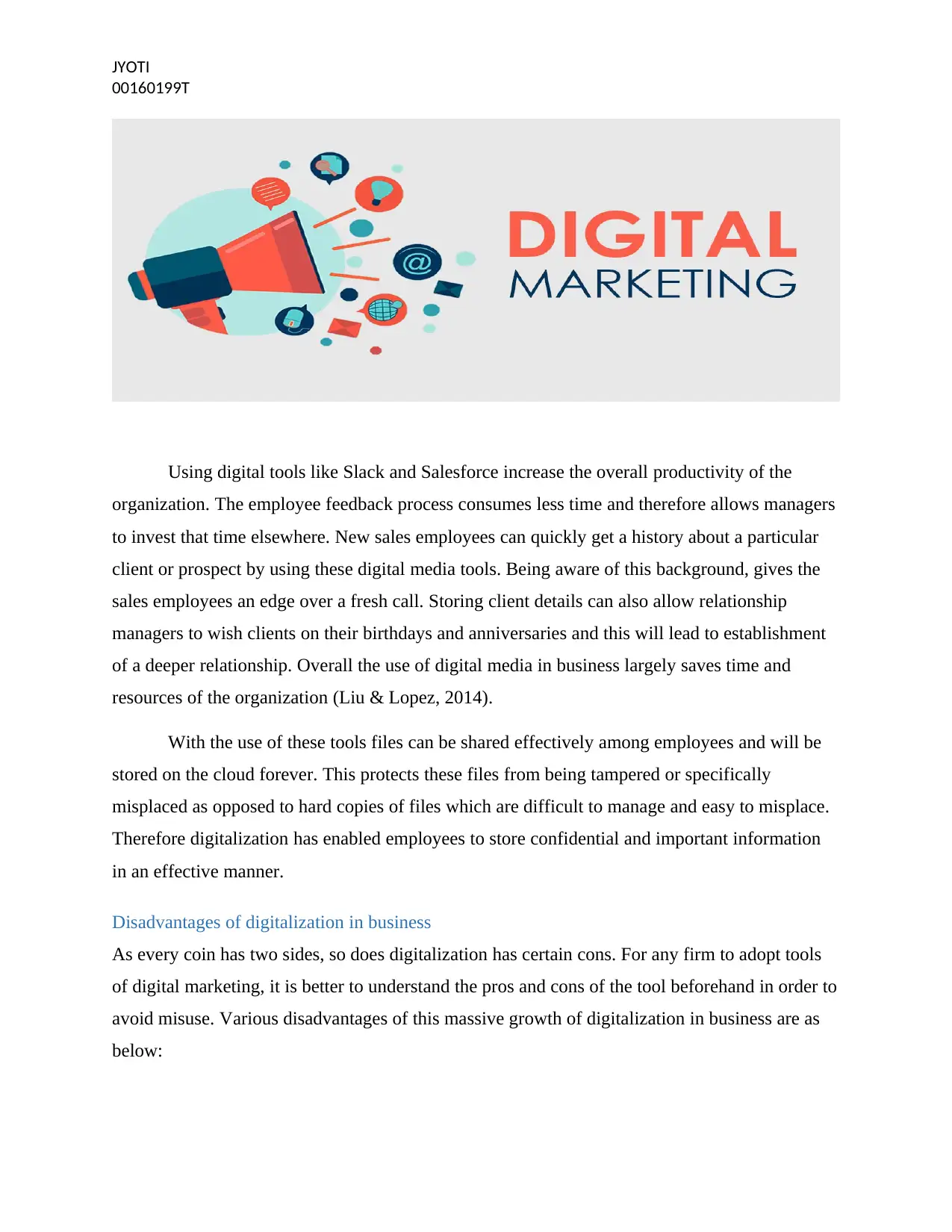
JYOTI
00160199T
Using digital tools like Slack and Salesforce increase the overall productivity of the
organization. The employee feedback process consumes less time and therefore allows managers
to invest that time elsewhere. New sales employees can quickly get a history about a particular
client or prospect by using these digital media tools. Being aware of this background, gives the
sales employees an edge over a fresh call. Storing client details can also allow relationship
managers to wish clients on their birthdays and anniversaries and this will lead to establishment
of a deeper relationship. Overall the use of digital media in business largely saves time and
resources of the organization (Liu & Lopez, 2014).
With the use of these tools files can be shared effectively among employees and will be
stored on the cloud forever. This protects these files from being tampered or specifically
misplaced as opposed to hard copies of files which are difficult to manage and easy to misplace.
Therefore digitalization has enabled employees to store confidential and important information
in an effective manner.
Disadvantages of digitalization in business
As every coin has two sides, so does digitalization has certain cons. For any firm to adopt tools
of digital marketing, it is better to understand the pros and cons of the tool beforehand in order to
avoid misuse. Various disadvantages of this massive growth of digitalization in business are as
below:
00160199T
Using digital tools like Slack and Salesforce increase the overall productivity of the
organization. The employee feedback process consumes less time and therefore allows managers
to invest that time elsewhere. New sales employees can quickly get a history about a particular
client or prospect by using these digital media tools. Being aware of this background, gives the
sales employees an edge over a fresh call. Storing client details can also allow relationship
managers to wish clients on their birthdays and anniversaries and this will lead to establishment
of a deeper relationship. Overall the use of digital media in business largely saves time and
resources of the organization (Liu & Lopez, 2014).
With the use of these tools files can be shared effectively among employees and will be
stored on the cloud forever. This protects these files from being tampered or specifically
misplaced as opposed to hard copies of files which are difficult to manage and easy to misplace.
Therefore digitalization has enabled employees to store confidential and important information
in an effective manner.
Disadvantages of digitalization in business
As every coin has two sides, so does digitalization has certain cons. For any firm to adopt tools
of digital marketing, it is better to understand the pros and cons of the tool beforehand in order to
avoid misuse. Various disadvantages of this massive growth of digitalization in business are as
below:
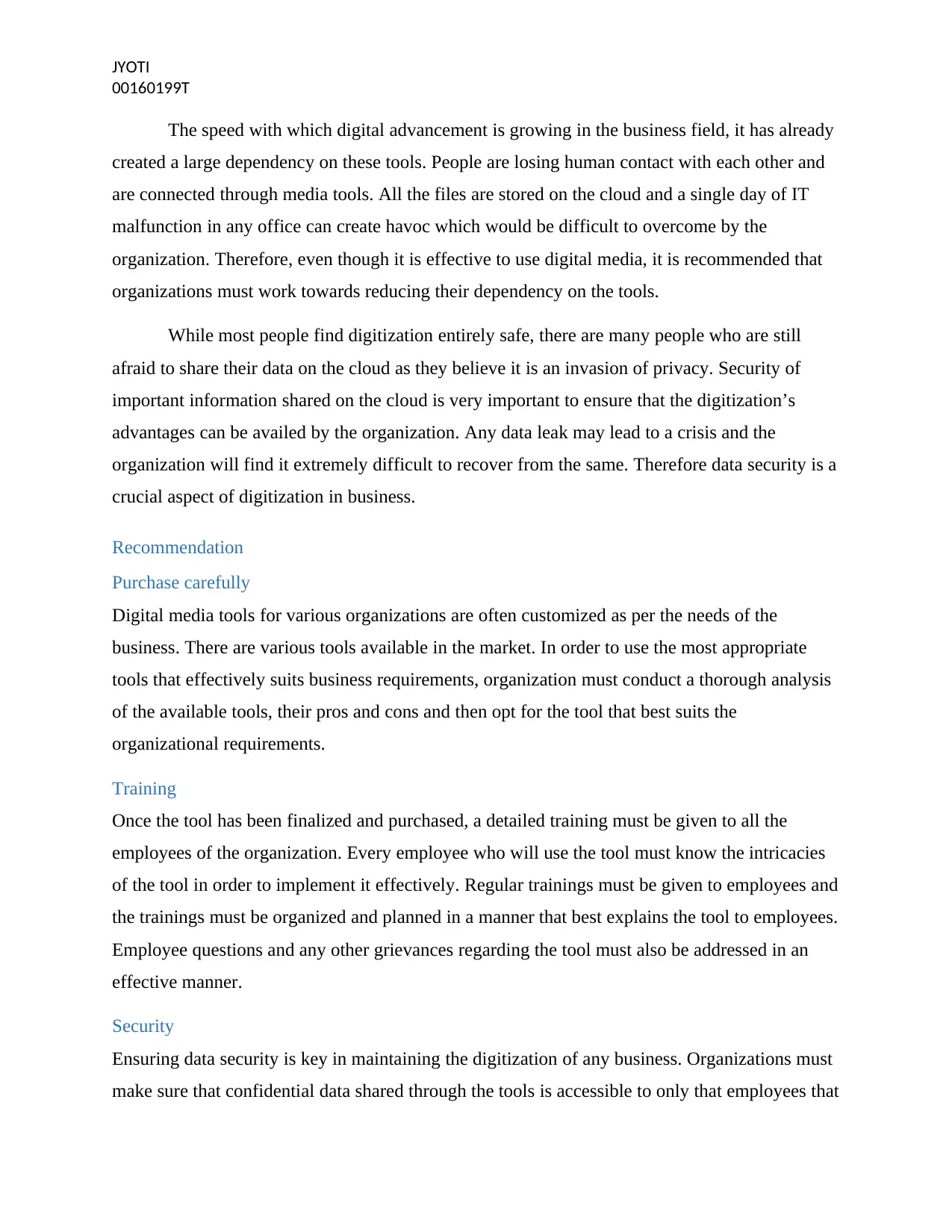
JYOTI
00160199T
The speed with which digital advancement is growing in the business field, it has already
created a large dependency on these tools. People are losing human contact with each other and
are connected through media tools. All the files are stored on the cloud and a single day of IT
malfunction in any office can create havoc which would be difficult to overcome by the
organization. Therefore, even though it is effective to use digital media, it is recommended that
organizations must work towards reducing their dependency on the tools.
While most people find digitization entirely safe, there are many people who are still
afraid to share their data on the cloud as they believe it is an invasion of privacy. Security of
important information shared on the cloud is very important to ensure that the digitization’s
advantages can be availed by the organization. Any data leak may lead to a crisis and the
organization will find it extremely difficult to recover from the same. Therefore data security is a
crucial aspect of digitization in business.
Recommendation
Purchase carefully
Digital media tools for various organizations are often customized as per the needs of the
business. There are various tools available in the market. In order to use the most appropriate
tools that effectively suits business requirements, organization must conduct a thorough analysis
of the available tools, their pros and cons and then opt for the tool that best suits the
organizational requirements.
Training
Once the tool has been finalized and purchased, a detailed training must be given to all the
employees of the organization. Every employee who will use the tool must know the intricacies
of the tool in order to implement it effectively. Regular trainings must be given to employees and
the trainings must be organized and planned in a manner that best explains the tool to employees.
Employee questions and any other grievances regarding the tool must also be addressed in an
effective manner.
Security
Ensuring data security is key in maintaining the digitization of any business. Organizations must
make sure that confidential data shared through the tools is accessible to only that employees that
00160199T
The speed with which digital advancement is growing in the business field, it has already
created a large dependency on these tools. People are losing human contact with each other and
are connected through media tools. All the files are stored on the cloud and a single day of IT
malfunction in any office can create havoc which would be difficult to overcome by the
organization. Therefore, even though it is effective to use digital media, it is recommended that
organizations must work towards reducing their dependency on the tools.
While most people find digitization entirely safe, there are many people who are still
afraid to share their data on the cloud as they believe it is an invasion of privacy. Security of
important information shared on the cloud is very important to ensure that the digitization’s
advantages can be availed by the organization. Any data leak may lead to a crisis and the
organization will find it extremely difficult to recover from the same. Therefore data security is a
crucial aspect of digitization in business.
Recommendation
Purchase carefully
Digital media tools for various organizations are often customized as per the needs of the
business. There are various tools available in the market. In order to use the most appropriate
tools that effectively suits business requirements, organization must conduct a thorough analysis
of the available tools, their pros and cons and then opt for the tool that best suits the
organizational requirements.
Training
Once the tool has been finalized and purchased, a detailed training must be given to all the
employees of the organization. Every employee who will use the tool must know the intricacies
of the tool in order to implement it effectively. Regular trainings must be given to employees and
the trainings must be organized and planned in a manner that best explains the tool to employees.
Employee questions and any other grievances regarding the tool must also be addressed in an
effective manner.
Security
Ensuring data security is key in maintaining the digitization of any business. Organizations must
make sure that confidential data shared through the tools is accessible to only that employees that
⊘ This is a preview!⊘
Do you want full access?
Subscribe today to unlock all pages.

Trusted by 1+ million students worldwide
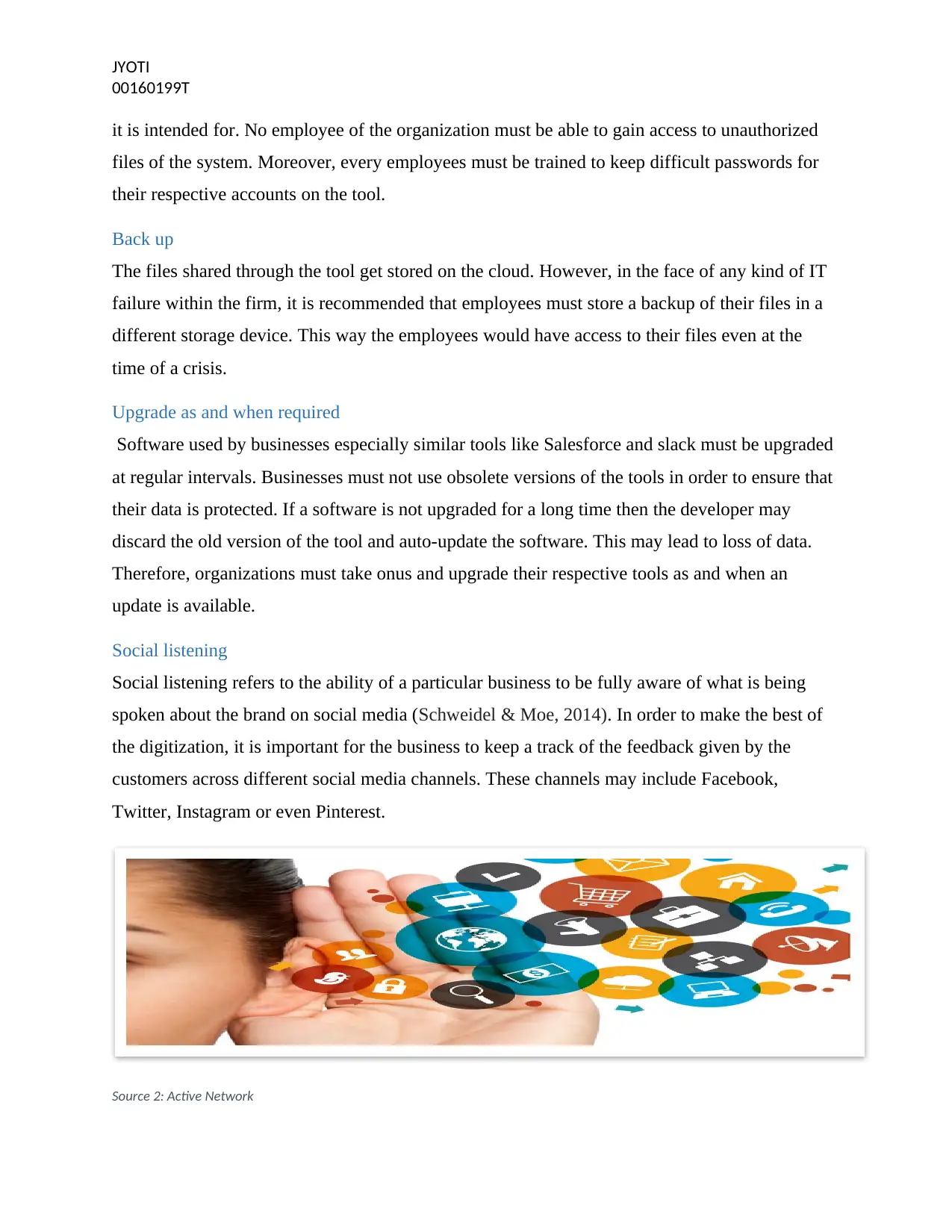
JYOTI
00160199T
it is intended for. No employee of the organization must be able to gain access to unauthorized
files of the system. Moreover, every employees must be trained to keep difficult passwords for
their respective accounts on the tool.
Back up
The files shared through the tool get stored on the cloud. However, in the face of any kind of IT
failure within the firm, it is recommended that employees must store a backup of their files in a
different storage device. This way the employees would have access to their files even at the
time of a crisis.
Upgrade as and when required
Software used by businesses especially similar tools like Salesforce and slack must be upgraded
at regular intervals. Businesses must not use obsolete versions of the tools in order to ensure that
their data is protected. If a software is not upgraded for a long time then the developer may
discard the old version of the tool and auto-update the software. This may lead to loss of data.
Therefore, organizations must take onus and upgrade their respective tools as and when an
update is available.
Social listening
Social listening refers to the ability of a particular business to be fully aware of what is being
spoken about the brand on social media (Schweidel & Moe, 2014). In order to make the best of
the digitization, it is important for the business to keep a track of the feedback given by the
customers across different social media channels. These channels may include Facebook,
Twitter, Instagram or even Pinterest.
Source 2: Active Network
00160199T
it is intended for. No employee of the organization must be able to gain access to unauthorized
files of the system. Moreover, every employees must be trained to keep difficult passwords for
their respective accounts on the tool.
Back up
The files shared through the tool get stored on the cloud. However, in the face of any kind of IT
failure within the firm, it is recommended that employees must store a backup of their files in a
different storage device. This way the employees would have access to their files even at the
time of a crisis.
Upgrade as and when required
Software used by businesses especially similar tools like Salesforce and slack must be upgraded
at regular intervals. Businesses must not use obsolete versions of the tools in order to ensure that
their data is protected. If a software is not upgraded for a long time then the developer may
discard the old version of the tool and auto-update the software. This may lead to loss of data.
Therefore, organizations must take onus and upgrade their respective tools as and when an
update is available.
Social listening
Social listening refers to the ability of a particular business to be fully aware of what is being
spoken about the brand on social media (Schweidel & Moe, 2014). In order to make the best of
the digitization, it is important for the business to keep a track of the feedback given by the
customers across different social media channels. These channels may include Facebook,
Twitter, Instagram or even Pinterest.
Source 2: Active Network
Paraphrase This Document
Need a fresh take? Get an instant paraphrase of this document with our AI Paraphraser
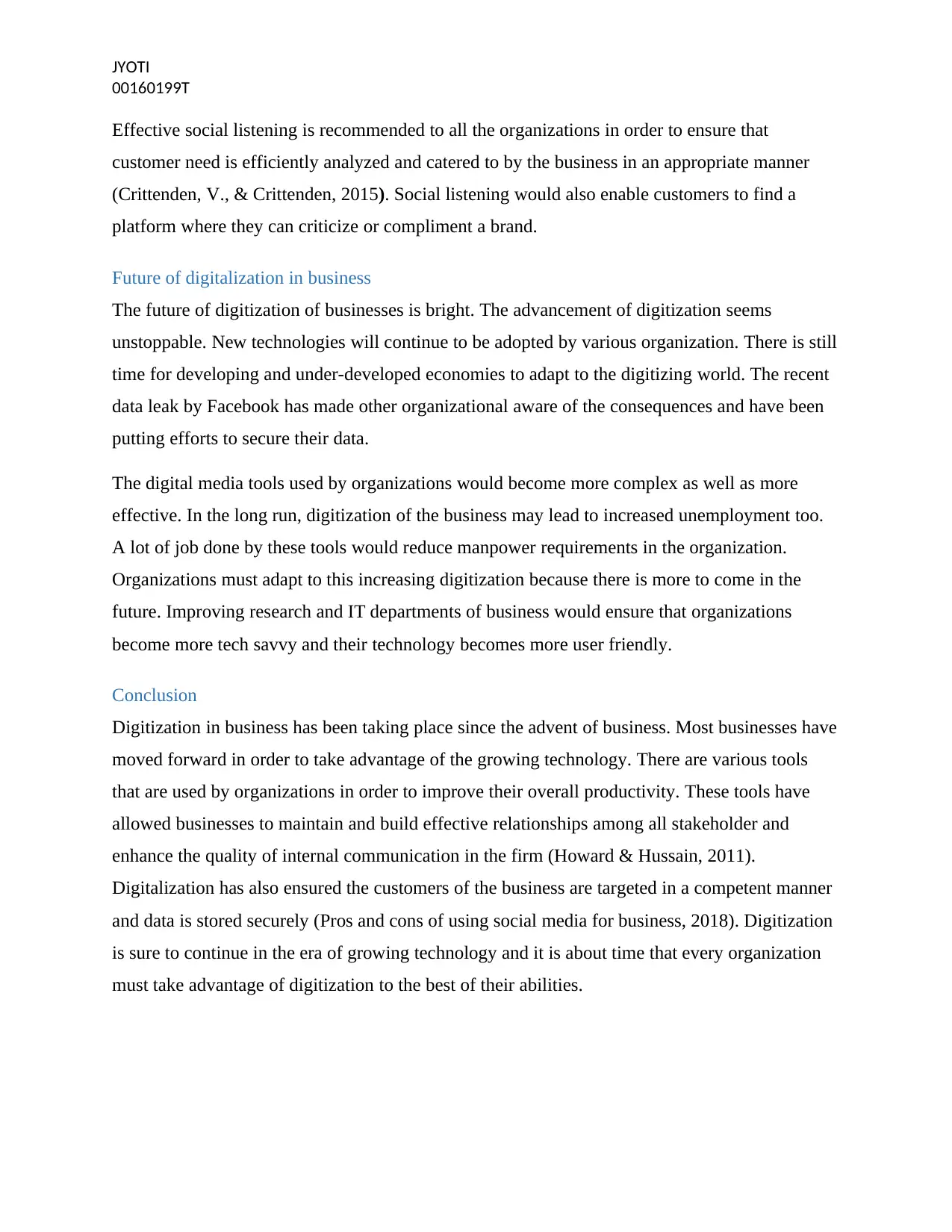
JYOTI
00160199T
Effective social listening is recommended to all the organizations in order to ensure that
customer need is efficiently analyzed and catered to by the business in an appropriate manner
(Crittenden, V., & Crittenden, 2015). Social listening would also enable customers to find a
platform where they can criticize or compliment a brand.
Future of digitalization in business
The future of digitization of businesses is bright. The advancement of digitization seems
unstoppable. New technologies will continue to be adopted by various organization. There is still
time for developing and under-developed economies to adapt to the digitizing world. The recent
data leak by Facebook has made other organizational aware of the consequences and have been
putting efforts to secure their data.
The digital media tools used by organizations would become more complex as well as more
effective. In the long run, digitization of the business may lead to increased unemployment too.
A lot of job done by these tools would reduce manpower requirements in the organization.
Organizations must adapt to this increasing digitization because there is more to come in the
future. Improving research and IT departments of business would ensure that organizations
become more tech savvy and their technology becomes more user friendly.
Conclusion
Digitization in business has been taking place since the advent of business. Most businesses have
moved forward in order to take advantage of the growing technology. There are various tools
that are used by organizations in order to improve their overall productivity. These tools have
allowed businesses to maintain and build effective relationships among all stakeholder and
enhance the quality of internal communication in the firm (Howard & Hussain, 2011).
Digitalization has also ensured the customers of the business are targeted in a competent manner
and data is stored securely (Pros and cons of using social media for business, 2018). Digitization
is sure to continue in the era of growing technology and it is about time that every organization
must take advantage of digitization to the best of their abilities.
00160199T
Effective social listening is recommended to all the organizations in order to ensure that
customer need is efficiently analyzed and catered to by the business in an appropriate manner
(Crittenden, V., & Crittenden, 2015). Social listening would also enable customers to find a
platform where they can criticize or compliment a brand.
Future of digitalization in business
The future of digitization of businesses is bright. The advancement of digitization seems
unstoppable. New technologies will continue to be adopted by various organization. There is still
time for developing and under-developed economies to adapt to the digitizing world. The recent
data leak by Facebook has made other organizational aware of the consequences and have been
putting efforts to secure their data.
The digital media tools used by organizations would become more complex as well as more
effective. In the long run, digitization of the business may lead to increased unemployment too.
A lot of job done by these tools would reduce manpower requirements in the organization.
Organizations must adapt to this increasing digitization because there is more to come in the
future. Improving research and IT departments of business would ensure that organizations
become more tech savvy and their technology becomes more user friendly.
Conclusion
Digitization in business has been taking place since the advent of business. Most businesses have
moved forward in order to take advantage of the growing technology. There are various tools
that are used by organizations in order to improve their overall productivity. These tools have
allowed businesses to maintain and build effective relationships among all stakeholder and
enhance the quality of internal communication in the firm (Howard & Hussain, 2011).
Digitalization has also ensured the customers of the business are targeted in a competent manner
and data is stored securely (Pros and cons of using social media for business, 2018). Digitization
is sure to continue in the era of growing technology and it is about time that every organization
must take advantage of digitization to the best of their abilities.
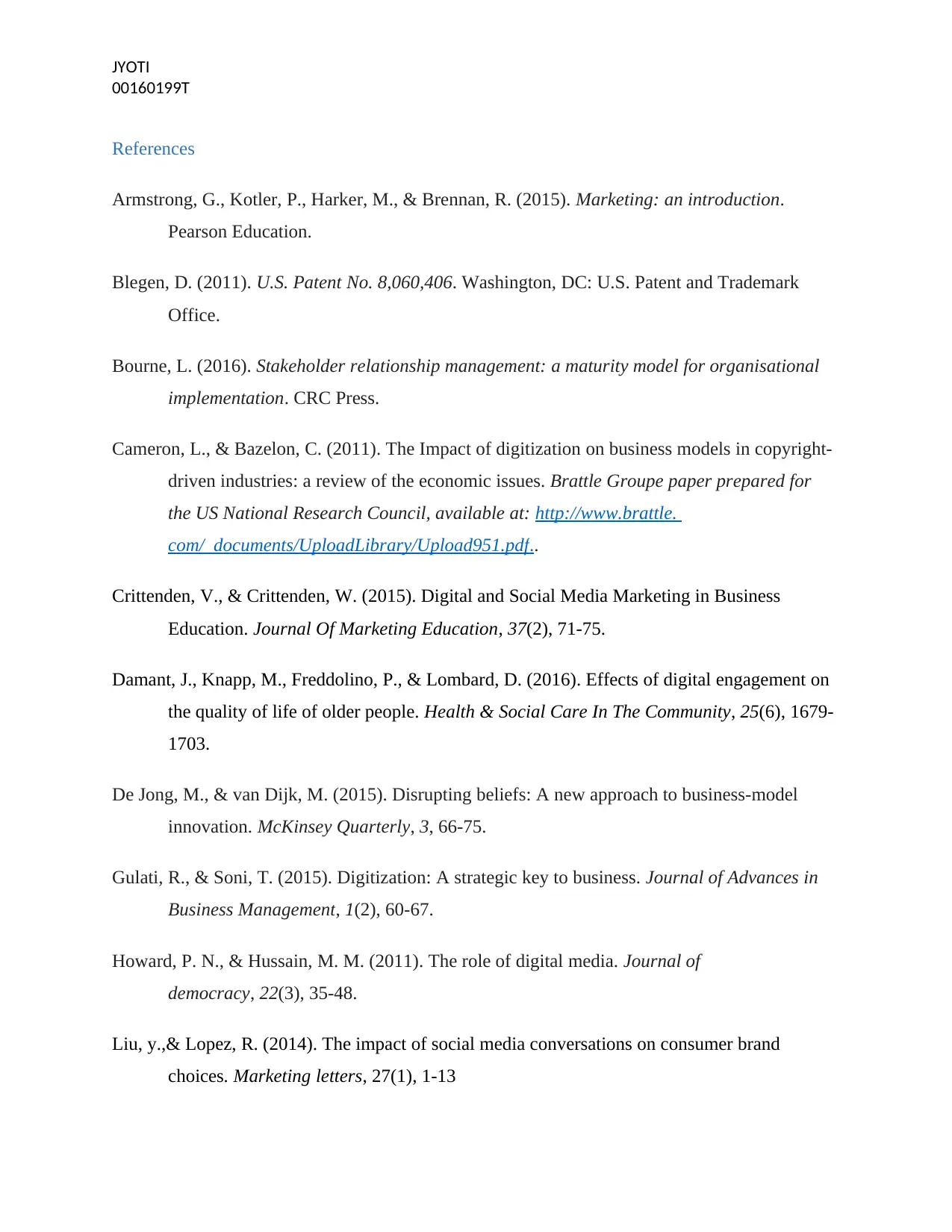
JYOTI
00160199T
References
Armstrong, G., Kotler, P., Harker, M., & Brennan, R. (2015). Marketing: an introduction.
Pearson Education.
Blegen, D. (2011). U.S. Patent No. 8,060,406. Washington, DC: U.S. Patent and Trademark
Office.
Bourne, L. (2016). Stakeholder relationship management: a maturity model for organisational
implementation. CRC Press.
Cameron, L., & Bazelon, C. (2011). The Impact of digitization on business models in copyright-
driven industries: a review of the economic issues. Brattle Groupe paper prepared for
the US National Research Council, available at: http://www.brattle.
com/_documents/UploadLibrary/Upload951.pdf..
Crittenden, V., & Crittenden, W. (2015). Digital and Social Media Marketing in Business
Education. Journal Of Marketing Education, 37(2), 71-75.
Damant, J., Knapp, M., Freddolino, P., & Lombard, D. (2016). Effects of digital engagement on
the quality of life of older people. Health & Social Care In The Community, 25(6), 1679-
1703.
De Jong, M., & van Dijk, M. (2015). Disrupting beliefs: A new approach to business-model
innovation. McKinsey Quarterly, 3, 66-75.
Gulati, R., & Soni, T. (2015). Digitization: A strategic key to business. Journal of Advances in
Business Management, 1(2), 60-67.
Howard, P. N., & Hussain, M. M. (2011). The role of digital media. Journal of
democracy, 22(3), 35-48.
Liu, y.,& Lopez, R. (2014). The impact of social media conversations on consumer brand
choices. Marketing letters, 27(1), 1-13
00160199T
References
Armstrong, G., Kotler, P., Harker, M., & Brennan, R. (2015). Marketing: an introduction.
Pearson Education.
Blegen, D. (2011). U.S. Patent No. 8,060,406. Washington, DC: U.S. Patent and Trademark
Office.
Bourne, L. (2016). Stakeholder relationship management: a maturity model for organisational
implementation. CRC Press.
Cameron, L., & Bazelon, C. (2011). The Impact of digitization on business models in copyright-
driven industries: a review of the economic issues. Brattle Groupe paper prepared for
the US National Research Council, available at: http://www.brattle.
com/_documents/UploadLibrary/Upload951.pdf..
Crittenden, V., & Crittenden, W. (2015). Digital and Social Media Marketing in Business
Education. Journal Of Marketing Education, 37(2), 71-75.
Damant, J., Knapp, M., Freddolino, P., & Lombard, D. (2016). Effects of digital engagement on
the quality of life of older people. Health & Social Care In The Community, 25(6), 1679-
1703.
De Jong, M., & van Dijk, M. (2015). Disrupting beliefs: A new approach to business-model
innovation. McKinsey Quarterly, 3, 66-75.
Gulati, R., & Soni, T. (2015). Digitization: A strategic key to business. Journal of Advances in
Business Management, 1(2), 60-67.
Howard, P. N., & Hussain, M. M. (2011). The role of digital media. Journal of
democracy, 22(3), 35-48.
Liu, y.,& Lopez, R. (2014). The impact of social media conversations on consumer brand
choices. Marketing letters, 27(1), 1-13
⊘ This is a preview!⊘
Do you want full access?
Subscribe today to unlock all pages.

Trusted by 1+ million students worldwide
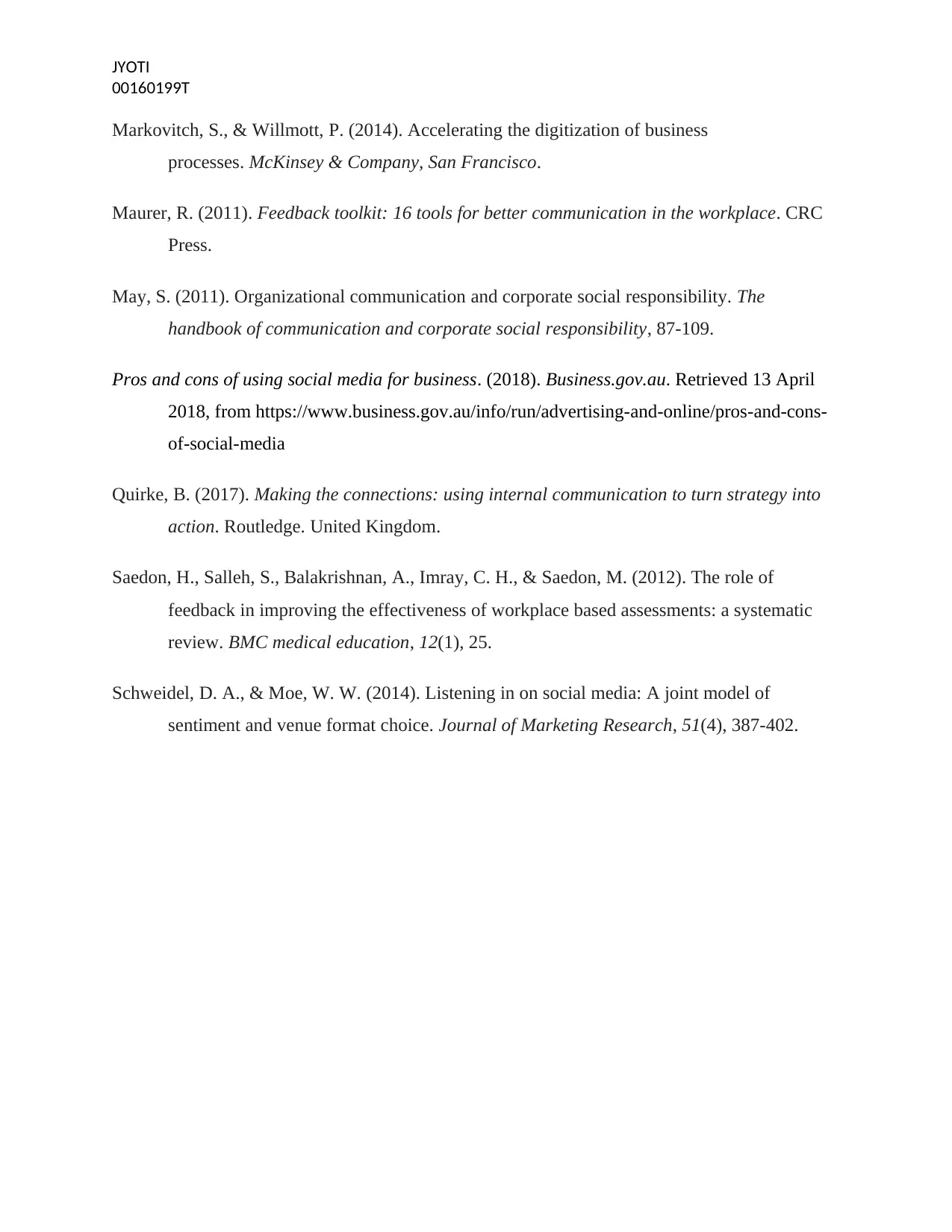
JYOTI
00160199T
Markovitch, S., & Willmott, P. (2014). Accelerating the digitization of business
processes. McKinsey & Company, San Francisco.
Maurer, R. (2011). Feedback toolkit: 16 tools for better communication in the workplace. CRC
Press.
May, S. (2011). Organizational communication and corporate social responsibility. The
handbook of communication and corporate social responsibility, 87-109.
Pros and cons of using social media for business. (2018). Business.gov.au. Retrieved 13 April
2018, from https://www.business.gov.au/info/run/advertising-and-online/pros-and-cons-
of-social-media
Quirke, B. (2017). Making the connections: using internal communication to turn strategy into
action. Routledge. United Kingdom.
Saedon, H., Salleh, S., Balakrishnan, A., Imray, C. H., & Saedon, M. (2012). The role of
feedback in improving the effectiveness of workplace based assessments: a systematic
review. BMC medical education, 12(1), 25.
Schweidel, D. A., & Moe, W. W. (2014). Listening in on social media: A joint model of
sentiment and venue format choice. Journal of Marketing Research, 51(4), 387-402.
00160199T
Markovitch, S., & Willmott, P. (2014). Accelerating the digitization of business
processes. McKinsey & Company, San Francisco.
Maurer, R. (2011). Feedback toolkit: 16 tools for better communication in the workplace. CRC
Press.
May, S. (2011). Organizational communication and corporate social responsibility. The
handbook of communication and corporate social responsibility, 87-109.
Pros and cons of using social media for business. (2018). Business.gov.au. Retrieved 13 April
2018, from https://www.business.gov.au/info/run/advertising-and-online/pros-and-cons-
of-social-media
Quirke, B. (2017). Making the connections: using internal communication to turn strategy into
action. Routledge. United Kingdom.
Saedon, H., Salleh, S., Balakrishnan, A., Imray, C. H., & Saedon, M. (2012). The role of
feedback in improving the effectiveness of workplace based assessments: a systematic
review. BMC medical education, 12(1), 25.
Schweidel, D. A., & Moe, W. W. (2014). Listening in on social media: A joint model of
sentiment and venue format choice. Journal of Marketing Research, 51(4), 387-402.
1 out of 10
Related Documents
Your All-in-One AI-Powered Toolkit for Academic Success.
+13062052269
info@desklib.com
Available 24*7 on WhatsApp / Email
![[object Object]](/_next/static/media/star-bottom.7253800d.svg)
Unlock your academic potential
Copyright © 2020–2025 A2Z Services. All Rights Reserved. Developed and managed by ZUCOL.





